A first-time visitor to Grand Marais might be surprised to see solar panels installed on house roofs, simply because this icy small town is a long way from the Sun Belt.
But first impressions are often misleading. Spending three nights in Grand Marais showed me that despite generally long snowy winters and many cloudy days throughout the year solar panels and solar energy are a growing trend.
I stayed in a beautiful house in this charming and peaceful small city in northeastern Minnesota with around 1,300 residents. Solar panels immediately caught my attention as I first arrived in their large front yard. I t surprised me to learn the owners typically pay no electricity bills thanks to the solar energy from April to January, when temperatures rarely fall below 40 F even in the coldest years, according to U.S. Climate Data.
t surprised me to learn the owners typically pay no electricity bills thanks to the solar energy from April to January, when temperatures rarely fall below 40 F even in the coldest years, according to U.S. Climate Data.
Chris O’Brien, who owns the house with his wife Jane Alexander, installed the solar panels thanks to his work experience as an engineer and business executive in the clean energy industry. As an engineer, he has been actively involved in clean energy solutions, particularly solar, since the 1980s.
After the couple bought the house in 2015, Chris designed and built a garage with a south-facing roof to optimize solar energy.
They were among the first residents in the neighborhood to install solar energy panels. Since then, many neighbors have followed suit.
“It is easy to implement,” says O’Brien, adding that there now are approximately 65 solar installations cumulative in town.
Their house gets up to 80 percent of its electricity from solar. The cold winters, where the average temperature remains below 30 F even in the hottest years, use the most electricity during the year, but still the solar panels produce about half the energy for the home’s heat and other electricity needs.

“During summer we create more energy than we need, so we sell this extra energy and our utility bill shows the amount of credit from this energy,” Chris explains. “We use more electricity in winter, so we use this credit in winter days.”
He refers to net metering, a program that credits solar homeowners for the extra electricity their solar power system generates and adds to the electric grid.
To install the 16kw solar energy system cost them $48,000 at that time, and they received a 30 percent tax credit. He estimates they will recoup the cost within 10 years.
In addition to making this obvious cost-benefit analysis, Chris believes that the residents of Grand Marais also have growing interest and concern about global climate change and therefore rely more on alternative energy sources, including solar ones.
Grand Marais residents have already begun to see the effects of climate change in the form of rising average temperatures, shifting plant and animal species and more clouds in their areas.




